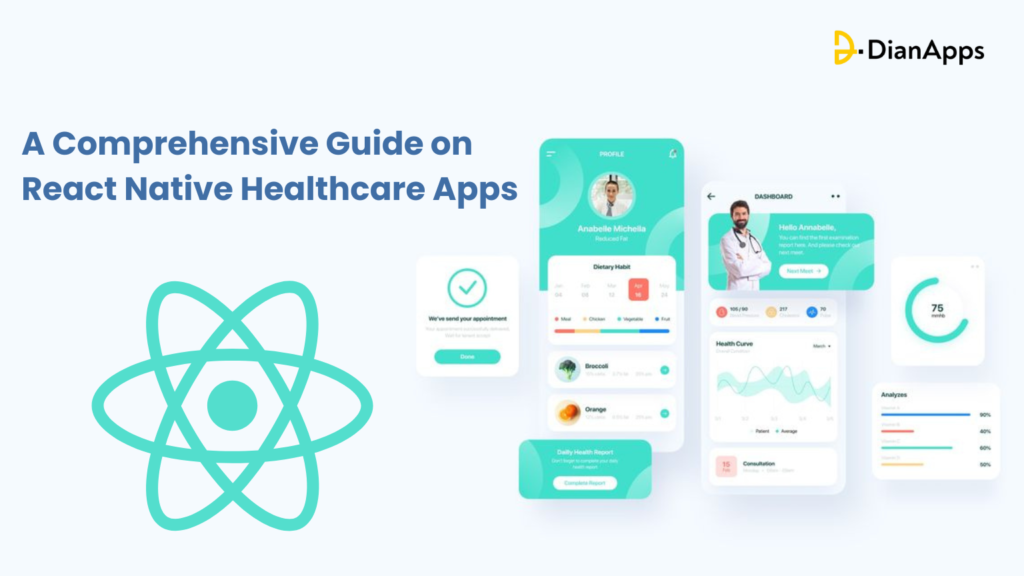Do you know, how many industries were affected by the COVID-19 emergence? As per reports, roughly two-third of the organizations (68%) saw a downfall in their business operations. As a result, the surge for safe medicine delivery and health consultation was needed.
Furthermore, businesses had to find a way to supply healthcare and wellness services to people in need. This urgency resulted in building Healthcare apps such as the Health tracking app, Appointment booking app, Medicine delivery app, Fooducate, HealthTap, WebMD, and whatever else.
Digital transformation in 2024 has welcomed the use of mobile applications more than ever. Healthcare app development solutions in the React Native framework are the two growing trends that are gaining traction and efficiency in the marketplace.
Why React Native is a good choice for Healthcare app development? In this guide, we will share some reasons and features. While also discussing its advantages, future trends and some insightful case studies.
Why Choose React Native for Healthcare App Development?
Facebook introduced React Native, an open-source JavaScript framework. It may be used as a cross-platform development tool to create web applications and mobile apps for several platforms.
Alright! Healthcare apps may be developed using a variety of cross-platform app development techniques, such as React Native. For healthcare apps, however, React Native is the better option for many reasons, some of which are listed below.
- Reusability and code maintenance make development easier using React Native.
- When developing cross-platform apps, React Native may save you up to 50% on development expenses over native app development.
- One code may be used to create a mobile healthcare application.
- Because it borrows a lot of features from the JavaScript library React, it’s the best option for creating user interfaces that are easy to navigate.
- React Native is known for its continuous integration of new features and versions such as the recent 0.73.
- The open-source community provides flexibility, responsiveness, and stable app development strategies.
What React Native Features Do You Need in Healthcare Apps?
1. Medical Tracking & Management
Healthcare apps can track and manage medical issues, treatments, and prescriptions more easily with the help of React Native. Data input is made simple with React Native’s interactive and mobile-responsive UI.
Tracking and managing health data is also made simpler by React Native’s real-time updates and interface. It thus improves the patient-provider relationship in terms of communication.
Supports Device Sensors
Healthcare applications need to have access to device sensors, and React Native easily satisfies this need. Tracking the whereabouts, movements, and activities of patients is made simpler by gaining access to gadget sensors such as GPS, accelerometer, and more.
Camera Integration
React Native healthcare apps may simply incorporate camera capabilities. It facilitates the taking and uploading of medical photos, including lab results and X-rays.
Seamless API integration
One of React Native’s specialties is simple API integration. It makes faultless real-time data retrieval and presentation from wearables and health monitoring gadgets possible.
Voice Detection
For the ideas and trends of healthcare apps, React Native provides voice recognition functionality. This feature allows patients and healthcare providers to enter data and manage their care hands-free.
2. Electronic Health Records (EHR) Integration
You may include Electronic Health Records (EHR) systems in your mobile healthcare application with the help of React Native app development services. EHR integration gives authorized medical staff members access to and evaluation of complete patient data using mobile healthcare applications.
Professionals may more easily keep track of patients’ medical histories, test findings, diagnoses, prescription lists, particular health conditions, and treatment plans when there is seamless access to data. The seamless integration of EHR systems made possible by React Native improves the efficiency of healthcare services and customer care coordination.
Integration of Native Module
By utilizing Native Module Integration, you can effortlessly combine native modules created in Java/Kotlin for Android and Swift for iOS with native EHR libraries and APIs. It guarantees a secure and safe flow of data between the EHR systems.
OAuth Security Measures
When it comes to supporting OAuth and other safe authentication mechanisms, React Native is the best. It is essential for starting the process of granting permission to access patient data stored in EHR systems.
HIPPA
The flexible design of React Native makes it simpler to put Health Insurance Portability and Accountability Act (HIPAA) compliance procedures into practice. It makes it possible to manage patient data security and privacy in compliance with industry requirements for the healthcare sector.
Use of HL7 & FHIR Data
Data communication between the healthcare app and the EHR system is facilitated by React Native’s compatibility with some health data standards, including HL7 (Health Level Seven) and FHIR (Fast Healthcare Interoperability Resources).
3. Safe Data Storage
Data is essential for medical applications since it contains all patient records. The React Native healthcare app recognized the need of data security at this point. It lets you store and protect large amounts of data.
These React Native capabilities provide great alternatives for managing and storing data.
AsyncStorage
React Native provides a straightforward, asynchronous, persistent key-value storage system called AsyncStorage. It may be used to store login tokens, user preferences, and settings, among other app data.
React Native SQL Support
React Native facilitates the creation and administration of very intelligent React Native local databases by supporting SQLite, a relational database management system. It handles structured data as well, which makes it a better option for managing intricate databases used in healthcare applications.
React Native Realm
A third-party database library called React Native Realm may be used to store data more quickly and securely. Healthcare apps benefit from stability and security in data storage because of their capacity to handle bigger datasets, synchronize data in real-time, and manage complicated data.
4. Custom UI/UX Design Services
The user experience is a key consideration when selecting a mobile healthcare application. The customizable UI components in React Native app development services let you create visually appealing and user-friendly interfaces. It lets you improve the user experience following the needs of the application.
Keep reading some proven ways to enhance your healthcare app UX for a better patient experience.
You may create interesting mobile apps for healthcare by customizing the style, color scheme, and interactive elements of your app with React Native. Additionally, it provides your healthcare app with a user-centric and tailored approach.
React Native Component Architecture
The architecture used by React Native is component-based, allowing UI elements to be divided into reusable parts. It makes it simple to style and modify individual UI elements.
Use of Flexbox Layout
React Native’s support for Flexbox Layout may be used to create layouts that adjust to various screen sizes and orientations. It enables you to design user interfaces that are strong, clear, responsive, and adaptable.
React Native Animation
Animated components are supported natively by React Native, enabling developers to build interactive and slick transitions and effects. To personalize UI/UX, you may select adaptable React Native animation libraries and UI elements.
Hot Reloading Feature
React Native’s Hot Reloading functionality makes it possible to see real-time UI changes while you write, which streamlines and perfects the customizing process.
5. Booking Online Appointments
Fast appointment scheduling is a crucial component of utilizing a healthcare app. Many patients prefer not to wait in line, and React Native makes it possible to schedule appointments quickly in the medical field.
It is designed to operate methodically with no appointments conflicting with one another. It will alert users if any appointments are already scheduled, making the booking process more efficient. Now, for the essential features:
React Navigation
A React Native module called React Navigation is used to create slick and fluid navigation flows that let users explore and make appointments with ease.
Time & Date Planner
Another built-in React Native component is a date and time picker. Selecting a chosen day and time for an appointment is made easier when it is used for appointment booking.
Integration of Redux
React Native healthcare app development may use the state management framework Redux. It makes it possible to create a centralized appointment data store, guaranteeing uniformity and accessibility across the application.
While those are some mind-blowing features to incorporate in your next Healthcare application, DianApps experts also advise businesses to carefully integrate these functionalities as it is complicated and may involve certain risks that can hamper the app’s performance. Hire a talented React Native app development company for effortless integration.
What are the React Native Healthcare App Trends of 2024?
The Use of AI & ML
The healthcare sector is not an exception to the growing usage of artificial intelligence (AI) and machine learning (ML). It assists in the diagnosis of illnesses and the prognosis of health problems. React Native app development and AI/ML technologies work together to provide a smart and tailored user experience.
AI chatbots can quickly address patient or user inquiries. AI-powered tools also allow you to evaluate data to improve patient care and make educated decisions.
Various Data Cloud Services
Multi-cloud-based services are the newest trend in React Native healthcare applications. You may offer smooth connection with a variety of cloud systems by using React Native. By storing sensitive data in data storage and adhering to privacy laws, it also helps to safeguard that data.
Cloud platform integration facilitates the optimization of healthcare application operations, be it for medical research or health record storage. It thereby increases the scalability of your program and effectively preserves data security.
Remote Patient Monitoring
Remote patient monitoring is another recent and exciting technology. By utilizing React Native, your healthcare application may track patient vital signs, instantaneously exchange information with them, and offer real-time consultations.
Furthermore, patients may use telemedicine services from any device, including tablets and smartphones, thanks to the cross-platform feature. It guarantees widespread and easy access to healthcare as a result. Efficient tracking and monitoring of patient records is also beneficial.
IoT Integration
IoT in healthcare is growing in popularity and changing due to its intelligent technology. React Native healthcare apps transform the way that healthcare is provided. Wearable watches and smart medical equipment are examples of IoT devices that monitor health conditions and collect patient data in real-time.
React Native’s connectivity with Internet of Things devices facilitates continuous and accurate patient data access, enabling individualized treatment plans, remote monitoring, and preventative care. Improvements in patient involvement, diagnostics, and proactive healthcare solutions will result from this combination.
DianApps React Native Healthcare App Case Study
Here are DianApp’s Success Stories behind building the Oberit (A wellness app) in the React Native Framework.
Our client needed a very responsive and user-friendly healthcare app interface, so we insisted on integrating the React Native app development service into their app project.
This is how their healthcare app development solution resulted:
1. Oberit:
Oberit is a mental health software that uses a novel method to establish new habits to redefine healing. Oberit is assisting users in developing wholesome, dependable habits that have been shown to lower the risk of mental health relapses by taking a more optimistic and long-term approach to addiction and mental health recovery.
Challenges involved:
- Syncing Data from Healthkit.
- Implementing MongoDB
How did we resolve these challenges?
- For accurate data optimization and increased productivity, we included time zones. Aside from timezone differences, steps and sleep data occasionally didn’t synchronize well.
- Strategically incepted MongoDB with the help of our React Native app developer’s expertise.
Technologies we implemented:
- React Native – Mobile App Front End
- ReactJS – Admin Panel Front End
- Backend – NodeJS
- DB: Mongo
Read the complete Oberit Case Study here!
Conclusion
A mobile healthcare application must be easy to use and intuitive for both medical professionals and patients. You must have realized why React Native is the best framework for developing mobile healthcare applications after reading this article. It makes sense to use React Native Healthcare Apps; its cutting-edge framework’s dynamic features and cross-platform development capabilities will revolutionize your application.
We are aware that you require a company on this difficult trip. We at DianApps are always happy to assist. You may get help from our renowned React Native app development company to create cutting-edge, safe healthcare mobility software. The specifications of your project will also be followed by our professionals when crafting your healthcare application.






